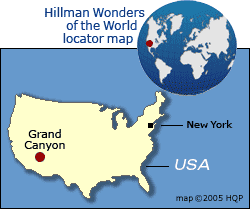Grand Canyon
 Why the
Grand Canyon
of America
is special
Why the
Grand Canyon
of America
is special"Grand" is an understatement.
At its extremes, the Grand Canyon is 446 kilometers (277 miles) long, up to 29 kilometers (18 miles) wide from rim to rim, and over 1600 meters (a mile) deep.
More than just vast
Vastness is just one of the mind-boggling elements of the Grand Canyon that renders me nearly speechless. The setting is desolate, the contours are rugged, and the striated hues of the gorges and pinnacles are vibrant.
When to go
Best months
The two best all-around periods are May and mid-September to mid-October. Crowds are relatively thin and the weather is pleasant (though, remember, the Grand Canyon weather can be unpredictable).
Grand Canyon summertime tips & insights
Expect simmer crowds
June to mid September is the peak tourist season.
Reservations
Make your summer reservations early for the in-the-park lodges and camps because they become completely booked months in advance. The same can be true for the accommodations outside the park for weekends and holidays. Sadly, many tourists arrive expecting miracles.
Parking
Enter the park early if you are a day tripper. Otherwise, you may have trouble finding a parking space.
Traffic congention
It can be nerve-racking. Leave your car parked and take the free shuttle bus to the major lodges and lookout points so you won't have to repeatedly search for scarce parking spaces.
Rain
Bring an umbrella. Heavy rains occur mostly in the summer, particularly in August.
Winter issues of the Grand Canyon
Thinking about coming in the winter to avoid the crowds?
Think twice. Grand Canyon is cold and can be snowy with icy roads. Moreover, daylight is short and winter storms can obscure the view.
Best Grand Canyon vantages
South Rim vs. North Rim
The view is best from the South rim - it has the most breathtaking vantage points. And, unlike the case on the north rim, the sun is over your shoulder, which is best for both sightseeing and for taking photos.
Best perspective view
For the most awesome and thrilling perspective, fly below its rims in a sightseeing helicopter (best bet) or small plane.
View from 7 miles up
To appreciate the size of the nearly 500-kilometer (300-mile) long Grand Canyon, view it at 35,000 feet aboard a commercial jet. Note: The flight paths of many transcontinental planes to and from major Southern Californian cities skirt this natural wonder.
Best viewing hours
Early morning or late afternoon on sunny days
These are the best time to see or photograph the Grand Canyon because the low angled sun rays intensify the hues of the rock layers.
Visiting the Grand Canyon floor
Mule ride
For an exciting trip, take the mule ride to the Grand Canyon floor. The trip is not recommended if you have a fear of heights because some sections of the trail are narrow and have steep drop offs without rails.
On foot
You can also hike to the bottom, but the roundtrip requires too much physical exertion and too many hours for other than a highly fit trekker. It's best to descend one day, camp overnight (permit required), then take the tiresome hike up the next day.
Via helicopter
You fly from the South Rim to the Grand Canyon floor. There will be time for a walk-around and (on some trips) lunch before helicoptering back to the rim.
Via boat
Another option is to travel through the Grand Canyon in an inflatable boat. Running the Colorado River rapids is a harrowing experience, which is part of the fun. Most trips last 5 to 8 days, some longer. One outfit offers a shorter itinerary - you helicopter in, do some rafting, then helicopter out.
It's scorching down there
Many visitors assume that the canyon floor is cooler than on the rim. It's not. July temperatures reach 41°C (106°F) and higher.
Wildlife
You'll be in the wild. Though rare, it's possible to cross the paths of rattlesnakes and mountain lions.
Visitor count
Millions
Over four million tourists visit the Grand Canyon per year. About 9 out of 10 of them choose the South Rim.
Grand Canyon origin
Slow in the making
It took the erosive effects of the Colorado River millions of years to carve a deep swath through billion-plus year-old rock layers.
Two stages
The process began in two stages, one roughly 17 millions years ago, the second, about 6 million years ago.
Other Grand Canyon tips & insights
Traveling to the opposite rim
The distance between the North Rim and South Rim main facilities is about 25 kilometers (15 miles) as the bird flies. By car, it's over 300 kilometers (200 miles).
Rim trail
The park has a rim trail for those who want a less populated view of the Grand Canyon.
Location in America



